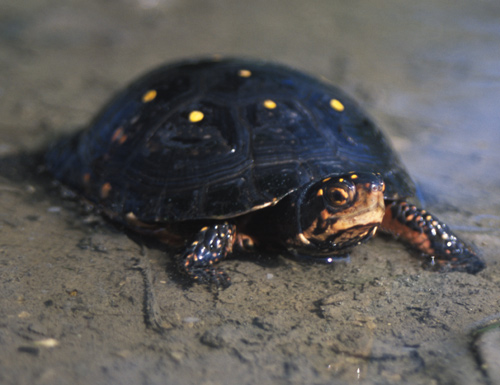The spotted turtle is a small turtle. Its shell, or carapace, is flat to moderately domed and smooth. It is black with yellow spots. The turtle's body is dark with an orange spot behind each eye and other orange markings on the head and limbs. The carapace of spotted turtles is 3 1/2 to 5 inches long.
Spotted turtles range along the Atlantic states from southern Maine to northern Florida. They extend west into Maryland, Pennsylvania and southern New York and into parts of Ohio, Indiana and Michigan. In Connecticut spotted turtles are found throughout the state in low-lying areas.
These turtles need a complex habitat system that includes wetlands and terrestial habitat. They are found in marshy meadows, vernal pools, wet woods, beaver ponds and shallow muddy streams.
Spotted turtles court and breed from March to May. Eggs are laid in June. A female digs a shallow, flask-shaped nesting cavity in sandy soil in a warm, sunny spot. She lays up to 8 elliptical eggs with flexible shells. Eggs hatch in late August or September. Sometimes hatchlings overwinter in the nest and come out in spring. A spotted turtle's lifespan is thought to be 26 to 50 years.
These turtles hibernate for the winter underwater buried in soft mud from October to April. They do more basking in the sun in the spring. Turtles cannot regulate their body temperature internally and must warm themselves in the sun. They are not seen as often in the summer and avoid the heat by resting in streams or digging under leaf litter.
Spotted turtle diet includes worms, small crustaceans, carrion insects, spiders, frogs, algae and some aquatic plants.
There has been a steady decline of the spotted turtle population because of habitat loss.
